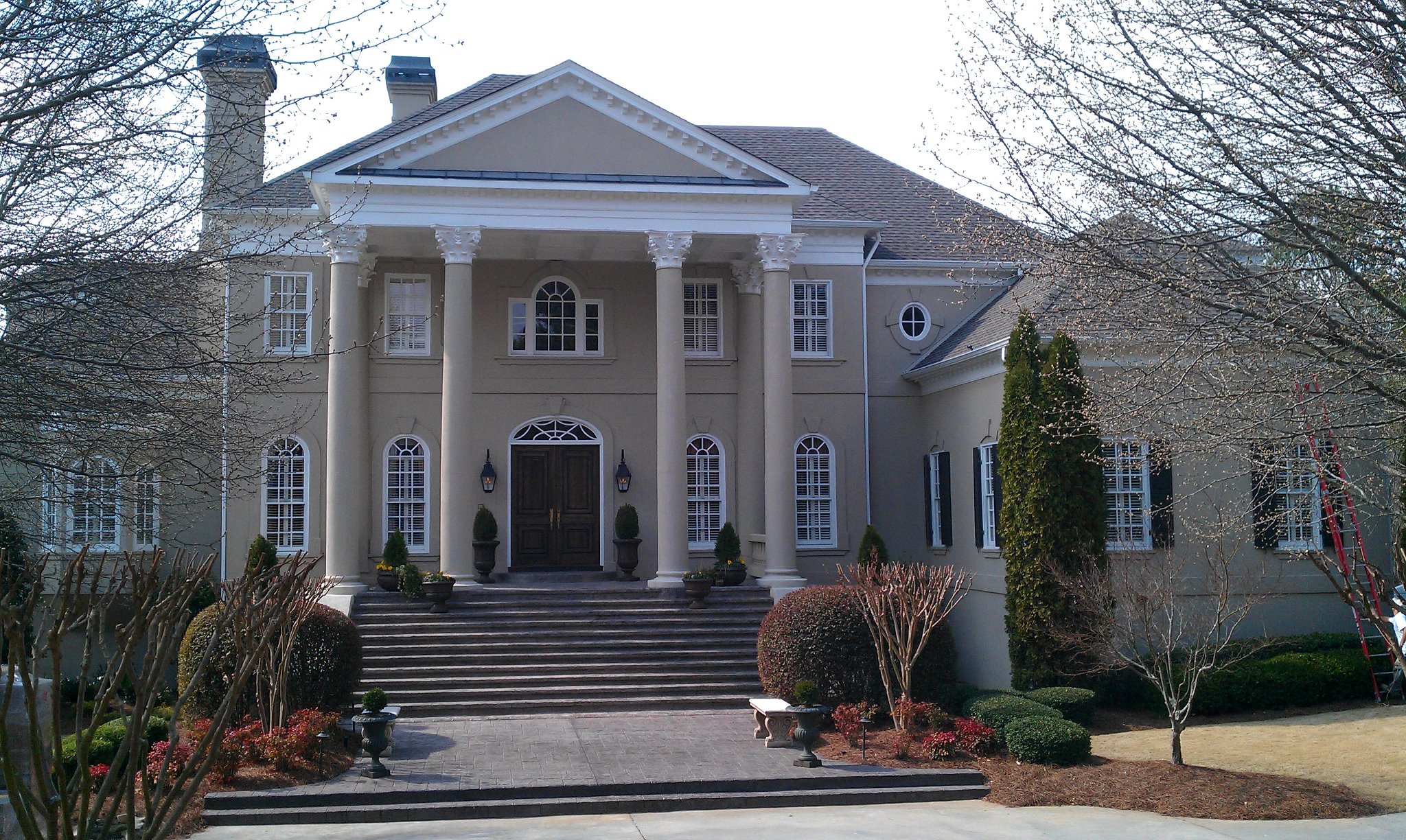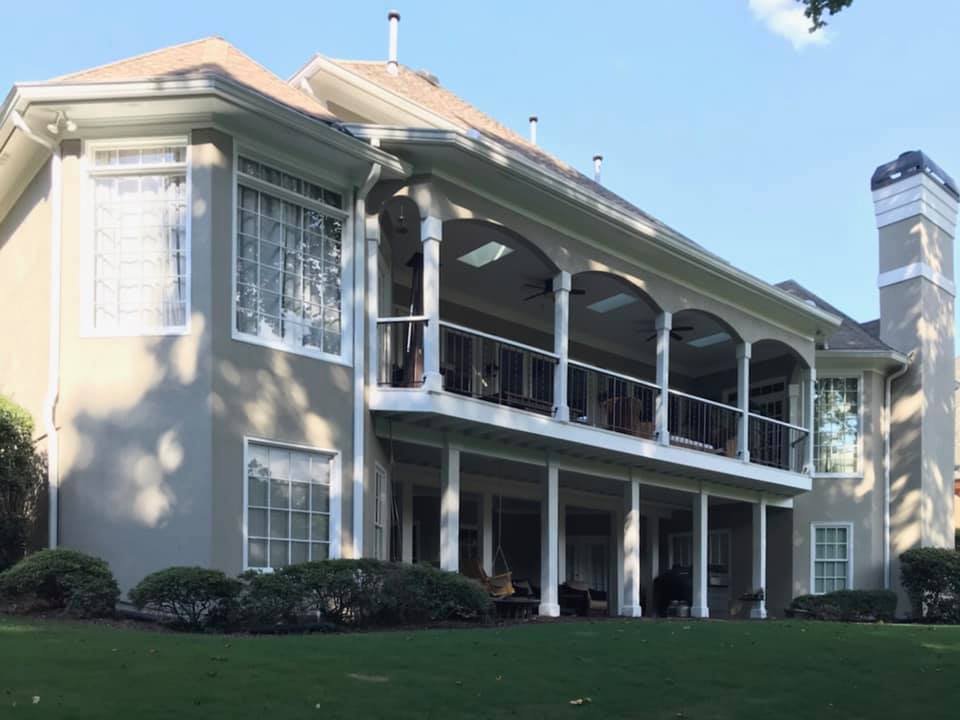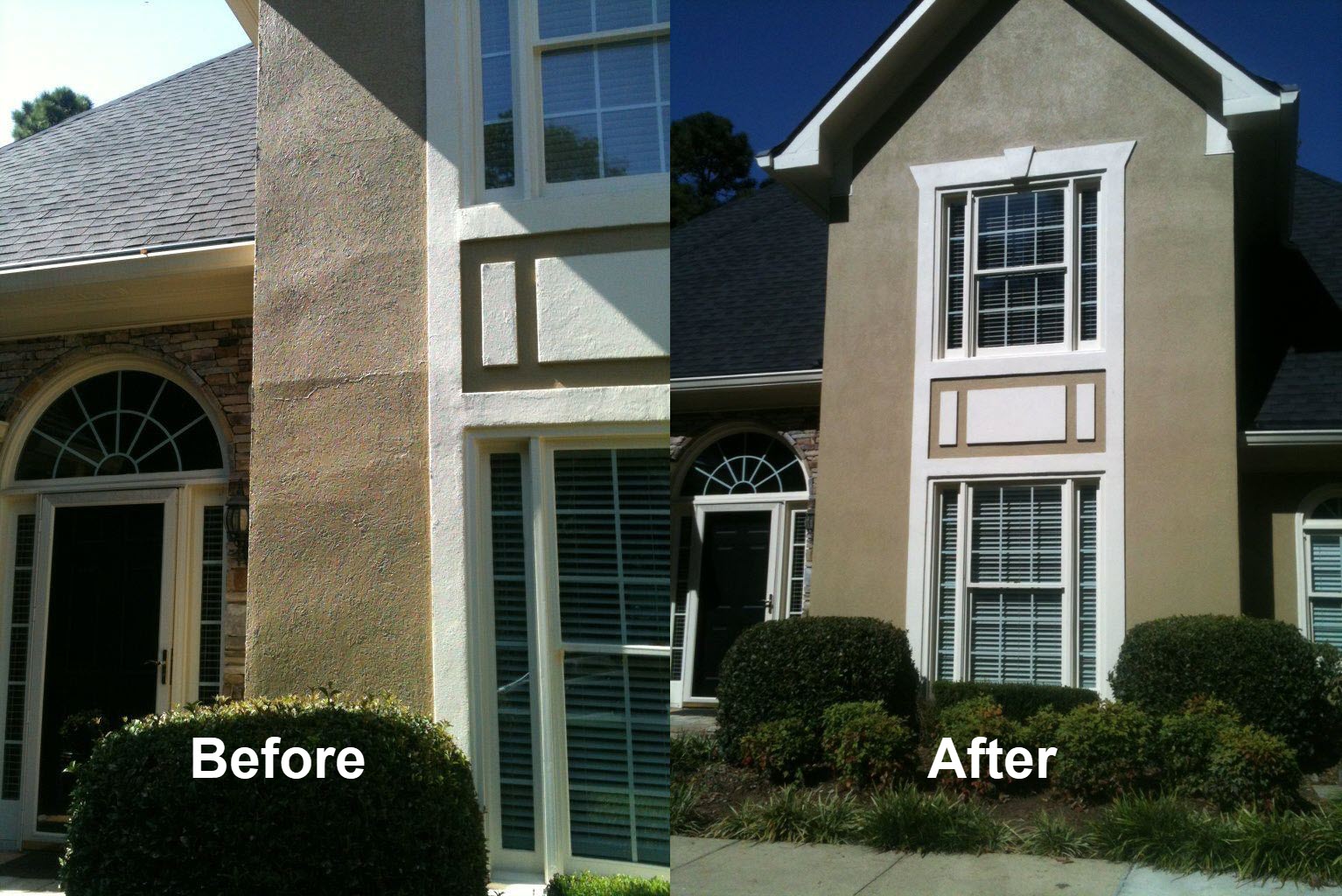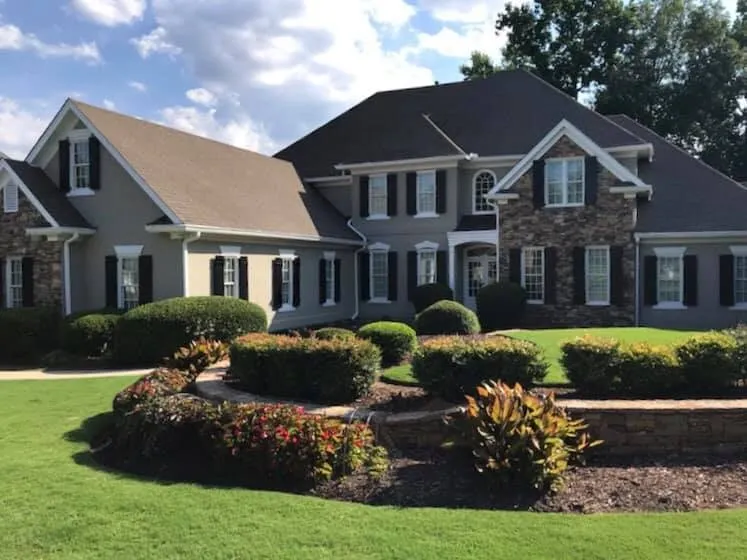Protective Stucco Coatingsin Vinings GA
Extend the Life of Existing Wall Systems
We Are Locally Owned & Operated For Over 24 Years
We Serve Businesses In And Around The Following Cities:
About Stucco and EIFS Protection Coatings in Vinings, Georgia
Exploring Stucco and EIFS Protection Coatings in Vinings Georgia
The rich architectural charm of Vinings, Georgia, a scenic suburb in Atlanta, is accentuated by buildings constructed with both historic and modern nuances. The area showcases a blend of brick facades, traditional wooden elements, and more recently, structures adorned with stucco and Exterior Insulation and Finish Systems (EIFS). These finishing touches contribute to the region’s aesthetic appeal and practical functionality. Integral to preserving the longevity and beauty of these surfaces are stucco and EIFS protection coatings. Here, we delve into the significance and application of these coatings, focusing particularly on the services offered by 'Advanced Stucco Repair', catering to both residential and commercial properties in Vinings.
Stucco, a centuries-old exterior finish, is praised for its durability and versatility. Its use has evolved, with modern adaptations like EIFS providing improved thermal insulation and moisture control. However, without appropriate protection coatings, these materials can succumb to environmental wear. Stucco and EIFS protection coatings play critical roles in preventing damage caused by wind-driven rain, mildew, and the relentless sun, all of which are common in Vinings' humid subtropical climate.
Understanding Stucco and EIFS as Building Materials
Stucco is a cement-based plaster, applied either on the exterior or interior of buildings. It consists of an aggregate, binder, and water, and is used to cover less visually appealing construction to create a polished look. EIFS, on the other hand, is a multi-layered exterior finish comprised of an insulation board attached to a substrate, a base coat reinforced with a fiberglass mesh, and a finishing coat. Notably, EIFS offers superior energy efficiency due to its insulative properties.
In Vinings, both stucco and EIFS are highly favored for their aesthetic flexibility and resilience. These materials can transform ordinary buildings into elegant structures that blend seamlessly with the lush landscapes. However, to maintain their appealing look and structural integrity, the importance of protective coatings cannot be overstated.
The Importance of Stucco and EIFS Protection Coatings
Protective coatings extend the lifespan of both stucco and EIFS, safeguarding these materials from damage caused by moisture infiltration and UV exposure. Without appropriate coatings, stucco's porous nature becomes a conduit for water penetration, which can lead to structural damage over time. EIFS, while more modern and effective in insulation, is not immune to wear and requires a top coat to enhance its protective capabilities.
In Vinings, where humidity levels can be high, applying a stucco water repellent is a proactive measure to prevent moisture-related issues. Similarly, an EIFS protective finish acts as a shield, warding off water and ensuring the integrity of the insulation. In addition, these coatings can be tinted or textured, thus contributing to the aesthetic appeal of the property.
Application Process of Protection Coatings
The process of applying protective coatings involves meticulous preparation and professional execution, especially in a sophisticated area like Vinings where property value and aesthetics are pivotal. Advanced Stucco Repair excels in this field, providing tailored solutions that meet the unique needs of each building.
The initial step involves cleaning the stucco or EIFS surface to remove any dirt, mold, or mildew. This ensures the coating adheres properly and achieves maximum effectiveness. Advanced Stucco Repair uses specialized cleaning agents that are gentle yet effective, preserving the original look of the materials.
Once the surface is clean, any necessary repairs are made. This might include sealing cracks or patching damaged areas, particularly in older buildings where stucco has cracked due to settlement or weathering. After repairs, a primer is often applied to ensure the coating adheres evenly and thoroughly covers the surface.
The protective coating is then applied, usually in multiple layers to ensure comprehensive coverage. Each layer is given time to dry and cure properly, preventing future peeling or blistering. Advanced Stucco Repair knows the local climate well, adjusting techniques as needed for humidity and temperature variations to optimize the results.
Benefits of Professional Application
Engaging a professional service such as Advanced Stucco Repair comes with numerous benefits, the foremost being expertise. Their experience in dealing with the specific architectural styles and environmental conditions in Vinings ensures that your building receives the best possible care.
Professionally applied coatings not only protect stucco and EIFS but also enhance their appearance. Skilled craftsmen can imbue surfaces with a range of finishes from smooth to textured, and even integrate color options that personalize and elevate the visual impact of your property.
Another significant benefit is increased property value. Using quality protective coatings prolongs the life and appeal of a building, making it more attractive to potential buyers or tenants. This is particularly pertinent in commercial real estate, where first impressions can significantly affect lease agreements or sales negotiations.
Practical Applications in Residential and Commercial Settings
The practical applications of stucco and EIFS protection coatings are manifold. For homeowners in Vinings, enhancing curb appeal while ensuring weather resistance is a compelling combination. Protective coatings keep homes looking pristine year-round, even in harsh climates, without frequent maintenance.
Commercial properties benefit substantially from these coatings as well. Vinings hosts various businesses ranging from charming boutiques to professional offices, all of which can suffer from unsightly exterior damage if not properly protected. Coatings applied by experienced professionals provide robustness against environmental elements and deliver a polished, inviting exterior crucial for customer-facing establishments.
In educational institutions, stucco coatings can harmonize modernization efforts with historic preservation, maintaining a seamless blend of tradition and progress in a neighborhood that values both. Similarly, hospitality businesses like hotels can ensure a consistent, high-quality appearance that reassures guests of their attention to detail and commitment to excellence.
Localized Insight into Vinings' Architectural Needs
Understanding the specific needs of Vinings in regard to stucco and EIFS applications is paramount. The city’s mix of classic Southern homes interspersed with contemporary developments requires a versatile approach to protective coatings. Advanced Stucco Repair is adept at handling this diversity, offering customized solutions that reflect both the environmental demands and aesthetic preferences of the area.
Homeowners renovating their properties or developers completing new projects can rely on Advanced Stucco Repair’s local expertise. Their knowledge of the unique weather patterns and architectural styles prevalent in Vinings ensures that their coatings are not only functional but also align with the visual standards expected in this refined community.
Advanced Stucco Repair: The Right Choice
With a host of providers available, choosing the right service for stucco and EIFS protection is critical. Advanced Stucco Repair offers not only technical proficiency but also an understanding of Vinings’ specific characteristics, ensuring an unparalleled level of service. Their commitment to high quality and customer satisfaction makes them a reliable partner for projects of any scale, from simple residential touch-ups to extensive commercial renovations.
Clients can appreciate the transparency and openness with which Advanced Stucco Repair operates, offering guidance and insight at every step from initial consultation to project completion. This holistic approach not only ensures outstanding results but also provides peace of mind, knowing that their properties are in expert hands.
In conclusion, stucco and EIFS protection coatings are invaluable for preserving the beauty and durability of properties in Vinings. Whether you are a homeowner looking to enhance your home’s curb appeal or a business owner seeking to make a striking impression, these coatings are an investment in both aesthetics and longevity. Advanced Stucco Repair stands out as a premier provider in Vinings, offering expertise and personalized service tailored to meet the community’s distinct needs. For those looking to protect and enhance their properties with stucco and EIFS solutions, contacting Advanced Stucco Repair is a prudent step toward achieving enduring quality and excellence.
Stucco and EIFS Protection Coatings Gallery



Call Us Today to receive your Free Quote for
Stucco and EIFS Protection Coatings in Vinings
Serving: Vinings, Georgia

About Vinings, Georgia
Early on, Vinings was known as Crossroads, and then Paces, after Hardy Pace, circa 1830. He operated Pace's Ferry across the Chattahoochee River, in this area between Atlanta, Buckhead, and Smyrna. Paces Ferry Road is still the main east–west road through Vinings. The Western and Atlantic Railroad laid rail tracks from Chattanooga, Tennessee to Atlanta in the 1840s. Vinings became a construction station for the railroad, and was inadvertently named for William H. Vining, as he worked on the railroad construction of "Vining's Bridge" laying tracks in the area. The railroad is still state-owned as it was from the beginning, and is now leased to CSX.
The Union Army occupied the Vinings area during Sherman's Atlanta Campaign of the American Civil War in 1864 and the subsequent March to the Sea. Pace's home, which had been used as a hospital for Union troops, was destroyed in the process. Vinings recovered after the war, as Governor Brown leased the railroad to Vinings to bring passengers to the springs and pavilions built to encourage a respite from the reconstruction of Atlanta. Vinings was officially recognized as a community in 1904, the same year the one-lane bridge was constructed across the Chattahoochee River. The town was never incorporated, though it had been discussed whether it should become a "township".
The Vinings Historic Preservation Society seeks to keep the town's history alive.
Vinings is located at 33°51′58.9″N 84°27′57.85″W / 33.866361°N 84.4660694°W. According to the United States Census Bureau, the CDP has a total area of 3.3 square miles (8.5 km), of which 3.2 square miles (8.3 km) is land and 0.1 square miles (0.26 km), or 3.34%, is water.
| Census | Pop. | Note | %± |
|---|---|---|---|
| 1990 | 7,417 | — | |
| 2000 | 9,677 | 30.5% | |
| 2010 | 9,734 | 0.6% | |
| 2020 | 12,581 | 29.2% | |
| U.S. Decennial Census 1850-1870 1870-1880 1890-1910 1920-1930 1940 1950 1960 1970 1980 1990 2000 2010 2020 | |||
Vinings was first listed as a CDP in the 1990 U.S. Census.
| Race / Ethnicity (NH = Non-Hispanic) | Pop 2000 | Pop 2010 | Pop 2020 | % 2000 | % 2010 | % 2020 |
|---|---|---|---|---|---|---|
| White alone (NH) | 7,805 | 5,913 | 6,459 | 80.66% | 60.75% | 51.34% |
| Black or African American alone (NH) | 1,155 | 2,679 | 4,049 | 11.94% | 27.52% | 32.18% |
| Native American or Alaska Native alone (NH) | 17 | 12 | 13 | 0.18% | 0.12% | 0.10% |
| Asian alone (NH) | 357 | 402 | 689 | 3.69% | 4.13% | 5.48% |
| Native Hawaiian or Pacific Islander alone (NH) | 2 | 6 | 3 | 0.02% | 0.06% | 0.02% |
| Other race alone (NH) | 15 | 38 | 62 | 0.16% | 0.39% | 0.49% |
| Mixed race or Multiracial (NH) | 107 | 182 | 476 | 1.11% | 1.87% | 3.78% |
| Hispanic or Latino (any race) | 219 | 502 | 830 | 2.26% | 5.16% | 6.60% |
| Total | 9,677 | 9,734 | 12,581 | 100.00% | 100.00% | 100.00% |
As of the census of 2000, there were 9,677 people, 5,227 households, and 1,740 families residing in the CDP. The population density was 3,039.2 inhabitants per square mile (1,173.4/km). There were 5,670 housing units at an average density of 1,780.8 per square mile (687.6/km). The racial makeup of the CDP was 81.97% White, 12.09% African American, 0.19% Native American, 3.69% Asian, 0.03% Pacific Islander, 0.83% from other races, and 1.21% from two or more races. Hispanic or Latino of any race were 2.26% of the population.
There were 5,227 households, out of which 11.5% had children under the age of 18 living with them, 26.3% were married couples living together, 5.2% had a female householder with no husband present, and 66.7% were non-families. 43.3% of all households were made up of individuals, and 2.4% had someone living alone who was 65 years of age or older. The average household size was 1.84 and the average family size was 2.61.
In the CDP, the population was spread out, with 10.8% under the age of 18, 15.5% from 18 to 24, 50.9% from 25 to 44, 16.6% from 45 to 64, and 6.1% who were 65 years of age or older. The median age was 30 years. For every 100 females, there were 92.5 males. For every 100 females age 18 and over, there were 91.8 males.
The median income for a household in the CDP was $88,876, and the median income for a family was $105,121. Males had a median income of $78,685 versus $46,315 for females. The per capita income for the CDP was $61,068. About 3.3% of families and 5.2% of the population were below the poverty line, including 4.1% of those under age 18 and 3.9% of those age 65 or over.
Vinings residents attend schools in the Cobb County School District. Residents are zoned to Teasley Elementary School, Campbell Middle School, and Campbell High School.
Vinings is unincorporated, and is therefore under the jurisdiction of Cobb's county commission and other public services. After the success of Sandy Springs, there was discussion and at least one public meeting on whether the town should also incorporate as a "city" (the only type of municipality in Georgia). With residents evenly split, there was no consensus, and the idea was shelved mainly due to concerns about potential property tax increases.
However, some expressed optimism that the Georgia Township Act might allow it to become a "township", equivalent in function to a village in many other U.S. states. This would allow it control of zoning and other land uses (the major dispute with the county), and as written would cap additional property taxes at a half mill (0.5 per mille, or 50¢ per $1000 annually). As of 2013, the bill has not been reintroduced in the Georgia General Assembly.
The proposed boundaries were Interstate 285 along the northwest side, Interstate 75 at the northeast end, the Chattahoochee River on the southeast side, and Atlanta Road (old US 41 until Cobb Parkway was built in the 1950s) at the southwest end.
